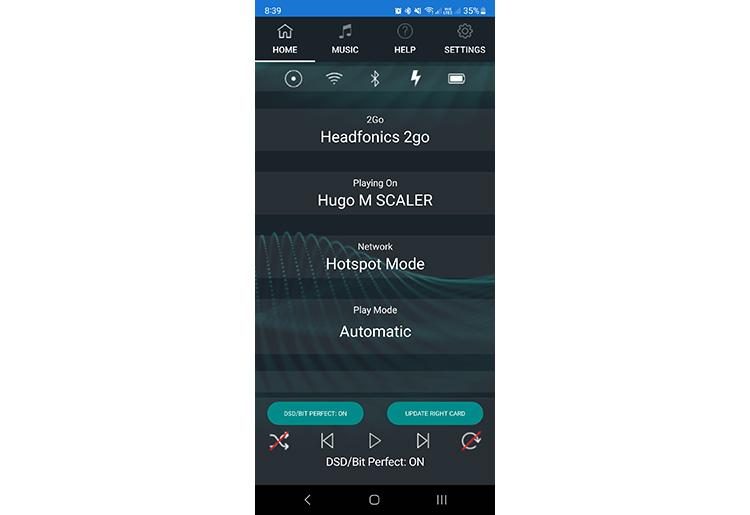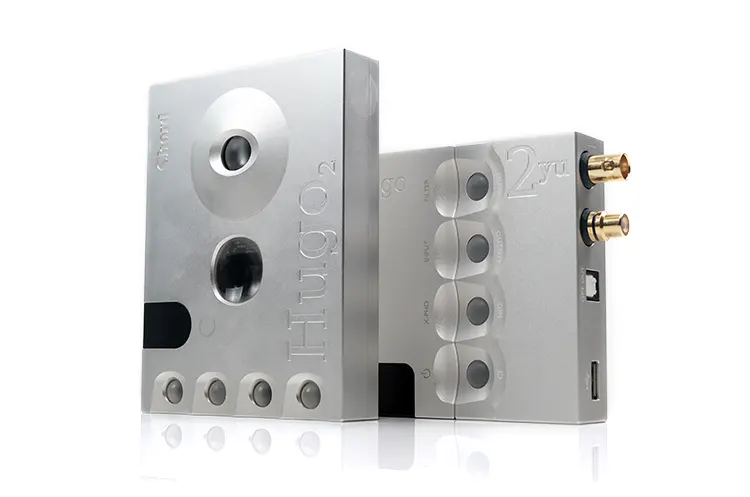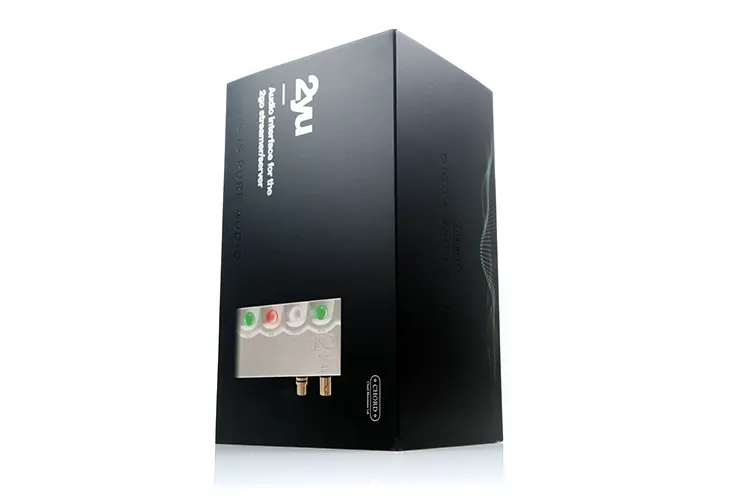Performance Impressions (with 2go)
The following 2yu performance impressions were created using the 2go‘s WiFi hotspot mode and via WiFi streaming using 3rd party software such as Roon for the desktop and BubbleUPnP for Smartphones and iOS.
Our desktop devices for primary testing were the Hugo M-Scaler linked to the Hugo TT2. We do not use an ethernet-capable network in our office currently.
USB
Whilst there are a lot of variables, not least the capability of the 2go, the output connection from the 2yu is possibly the final arbiter in terms of the type of audible performance you will get.
Using an M-Scaler combined with the TT2 and the USB output of the 2go/2Yu in WiFi mode will probably get you the most compelling and dynamic performance of the possible connection options with BNC and Coaxial just slightly behind.
It is also the most resolving and comes very close to a direct USB connection to the M Scaler from a PC using lossless tracks with excellent treble headroom and a tight and clean bass response.
The one important note here is to switch to DSD/Bit Perfect mode to move the volume control to your component of choice. Without this you are at the mercy of software volume controls which are never quite as resolving as Bit Perfect output from our experience using the same setup in DAPs for the last few years.
Keeping Bit Perfect mode also simplifies volume control levels. Do you not need to check if your software volume level is high enough to prevent you from having to tweak the volume upwards on the likes of the Hugo TT to even Roon’s own pre-gain to compensate.
Optical
The optical performance was quite different to my ears using the Focal 2022 as our tested headphone.
Generally, a bit softer sounding and warmer with a bit more bloom in the bass performance though not as tight and punchy. Some of the treble presence got reduced a little whilst the dynamic range, (hence softness), felt comparatively attenuated.
If you are using the M Scaler, I would keep the resolution at the maximum setting for the 2go/2yu optical performance. Going down to regular 44.1k sampling left everything sounding quite muted and dull in tone.
Upsampling to 705/768kHz gives some necessary vibrance to the performance and some additional dynamics and perceived depth to the staging of the Focal 2022.
I still think the same setting via USB is the ideal way to go with that improved treble giving everything from the mids downwards some additional perceived clarity and a more accurate harmonic balance.
I would choose FIL1 incisive neutral filter from the Hugo TT2 output to keep the optical performance as clean as possible, especially with the Focal Utopia 2022 which is a relatively warm to natural sounding headphone.
For USB, I would still default to FIL1 as a personal preference but you can get away with the warmer filters with hi-res formats that do a bit more HF noise shaping. Some personal preference will be a factor here as the filters are less dramatic in their effect compared to the M Scaler’s upsampling capabilities.
BNC & Coaxial
The 2yu BNC/Coaxial output sits somewhere in between the USB and optical performance going direct to the Hugo TT2 without using the M Scaler and paired with the LCD-5. I would argue it’s closer to the energy and dynamics of the USB performance but with slightly less treble brilliance.
The optical performance still sounds more relaxed when compared to BNC with a mids to treble presentation that attenuates and feels more atmospheric but with less bite and presence.
The BNC/Coaxial performance also offers a more robust low-end on the TT2 compared to optical. There is less bloom so timbre-wise it shades more to the neutral-natural but not quite as clean and reference-like as the 2yu USB connection.
It’s actually a nice pairing with the LCD-5, possibly more so than the Focal 2022 which really takes to the cleaner USB output for my tastes. That more natural lilt and solid punchy bass performance keep the LCD-5 strong upper mids more in check.
Bear in mind, without the Hugo M Scaler upsampling capability the BNC connection is limited to DSD64 and I do have some DSD128 in my collection which is where you want to switch over to USB, or else the audio will mute.
The Hugo M Scaler will upsample any incoming BNC signal from the 2yu but with conversion to PCM before outputting at up to 705/768kHz.
Bluetooth
As with the 2go review comments, I would not recommend switching to 2go’s BT connection purely for audio delivery through the 2yu unless no other option.
There is a considerable drop in dynamic range and resolution compared to the WiFi lossless equivalent, especially so when you compared the excellent hotspot mode from 2go and using its locally stored media server’s capability which I rate even higher than the WiFi performance for crystal clear audio and a black background.
The only technical WiFi limitation is more to do with the 2go’s 2.4 GHz-only capability for WiFi which has nothing to do with the 2yu’s performance. I did find our modem a bit fussy for 2.4 GHz with some bottlenecking and signal drops on hi-res playback, (24BIT/192kHz and above), at certain times of the day.
Synergy
The following pairings were compiled using the Audeze LCD-5 and the Focal Utopia 2022 with the Hugo TT2 and the Chord Electronics Anni as the main amplifiers when combined with alternative DACs. For the Hugo 2 and Mojo 2 pairing, we used the Nostalgia Audio Tesseract and the Unique Melody Multiverse Mentor IEMs.
Chord Electronics Hugo 2 / Mojo
It is a good bet if you have the 2go then you might have the Hugo 2 also. Moving to the 2yu to open up the 2go’s streaming capability to desktop DACs does not necessarily negate the detached Hugo 2’s relevance.
For those wishing to retain the Hugo 2 as their desktop DAC/amp as well as avoid the 2go running out of battery at inopportune moments then the 2yu power system, which also charges the 2go at the same time, creates a very useful long listening session scenario.
Even simply attaching and detaching the 2go every time you want to use the 2yu or the Hugo in a desktop setup is not required with its ability to receive a micro-USB, coaxial, and optical digital audio input.
The Mojo 2 also becomes a considered choice with its own coaxial, optical, and USB inputs for those who want to stream to an IEM-friendly compact DAC/amp without wishing to go portable and buy the Poly also.
If you have both a Mojo and a Hugo 2 you can simply swap them around using one of the relevant connections from the 2yu and save a lot of time switching from one modular streamer to another.
Performance
It’s really the go/2yu hotspot mode with local storage that stole the honors here over my own WiFi setup. Every 2yu output sounded dynamic and more precise with a blacker background compared to wireless streaming from my desktop setup.
However, no matter whether WiFi or hotspot mode, the USB output was the clear winner in terms of clarity and dynamic range.
The optical and coaxial inputs to the Hugo 2 did have quite a marked difference from what I heard in the M Scaler/TT2 setup but both did sound relatively muted for dynamics compared to the USB connection.
You do pick up more of that difference in hotspot mode with the optical performance showing some softness and a vocal presence drifting further from the stage relative to a fulsome bass low-end.
The coaxial output kept things a lot tighter giving vocals more vibrancy and pushing them further forward. Of the two, coaxial was the better performer over optical but both paled to the improved headroom and treble presence from the USB.
I did not have the correct coaxial cable to test its performance with the Mojo 2, but no question the USB link with 2yu offered a cleaner more holographic sound compared to the optical connection.
The Multiverse Mentor is a natural to slightly warm tone with a firm low-end, it needs control and clarity and the USB performance into the Mojo gave it that.
With Mojo 2 you can further tip the balance with its built-in EQ to fine-tune so perhaps targeting the 3kHz treble shelf option there will bring in a bit more fizz into the optical performance should you require it.
Chord Electronics Qutest
No problems for the 2go/2yu to find the Qutest via the Gofigure app home screen and you do have a wealth of connectivity options including BNC, USB, and optical.
It should come as no surprise then, given our commentary throughout, that the USB connection remains the consistent performer in terms of dynamic range and resolution. Even more so with the 2go/2yu in hotspot mode.
If you are using the Anni stackable amplifier here the USB output is probably the modality I would recommend for the majority of headphones.
The optical input will take the edge a little off harsher treble presentations if you do not mind more bass bloom on the lows and a little less punch and definition at the same time.
Perhaps not the most revealing output mode for the Anni, however, with instrumental placement and separation a little hazier with headphones such as the MM-500 and Meze Audio’s Elite.
Ferrum ERCO
I had no issues with the setup though you will have to change the stock USB cable that comes with 2yu with a USB-C terminated version for compatibility with the ERCO USB input. Once sorted, it will recognize the ERCO via Gofigure with coaxial and optical alternative options, (no BNC).
It should come as no surprise that the mobile hotspot 2yu USB connection gave the clearest and most dynamic performance using the Audeze MM-500 in a high gain mode. No change there then from the previous Chord ecosystem test results.
However, this time I actually enjoyed the 2yu optical output with the MM-500. The Coaxial does give a stronger treble presence and generally feels tighter across the spectrum. It also feels more extended in the highs whereas the optical was comparatively attenuated in the same region and generally warmer as a result.
However, this warmer fuller optical tone suits the MM-500 tuning a bit more sounding more smoother to my ear and not as edgy in the upper-mids. The coaxial is more resolving but the overall tone was neutral and a bit flatter and I would rather give up a bit of fine detail in return for a more agreeable timbre.
Holo Audio Spring DAC 2 “Wildism Edition”
For this analysis, I used the HIFIMAN Susvara combined with the Feliks Audio Envy and the Spring DAC 2 in NOS mode.
With this DAC you get to use every single option from the 2yu, including USB, coaxial, BNC, and optical. On top of that, you can further shape the sound via the DAC’s own R-2R NOS, and 3 oversampling modes including PCM, and DSD options.
Also, with a PC setup you need Holo Audio’s dedicated ASIO driver for it to work via USB but with the 2yu it worked the instant I connected it with Gofigure recognizing the DAC name so, driver compatibility is just fine.
As far as performance goes, both the BNC and coaxial inputs are virtually identical in performance with the optical output coming in behind in terms of clarity and dynamics.
Both the BNC and coaxial inputs are more neutral sounding, punchier, and cleaner on the highs. The optical projects a more relaxed tone, with a smooth timbre but it’s not as revealing with the Susvara picking up a lack of extension and headroom right away.
BNC and coaxial do a much better job in terms of micro-detail and can better match Susvara’s excellent transient speed, especially on the lows and the bass layering.
Of course, all three options pale in comparison to the USB mode which sounds immediately more incisive and resolving, especially in terms of staging depth and just how quickly the entire system throws spatial notes around the entire stage.
Granted, you lose a little warmth but the leap in dynamics is very compelling on the Susvara, especially using hotspot mode.
Our Verdict
Peer deep into the Chord Electronics ecosystem and there you will find the very unique 2yu.
Less of an audio device in its own right, the 2yu is more of an enabler, or a gatekeeper of sorts taking the 2go from portable to desktop and directly to the likes of the Hugo M Scaler and TT2.
Granted, the primary appeal of the 2yu is going to be to Chord desktop and 2go owners since it’s nothing without that streaming device attached to it. Once integrated it converts into a very capable desktop streaming unit.
It’s also a very simple and well-built device to integrate and learn how to use and provides some very important value add to the 2go, which up until the launch of the 2yu, was an entirely singular portable application streaming device for Hugo 2 users.
Now it can be bought with the 2go and used by anyone looking for a compact and capable streaming solution for their desktop, (and HiFi), audio system. Not just Chord customers, but any DAC owner out there.
Chord Electronics 2yu Technical Specifications
Power supply
- Micro USB (5v 1amp minimum required) – through 2go
PCM and DSD support
- 44.1kHz – 768kHZ | DSD 64 to DSD 256 (Dependant on output)
Sample rate converter:
- Integrated, automatic downsampling is provided if a higher sample rate is being played than the output can support.
Digital audio outputs:
- USB Type-A (44.1kHz – 768kHz / DSD 256)
- BNC Coax (44.1kHz – 384kHz /DSD 64)
- RCA Coax (44.1kHz – 384kHz /DSD 64)
- Optical (44.1kHz – 192kHz / DSD 64)
Processing power
2000MIPS
Weight with 2go
- 361g
Dimensions with 2go
- 115mm (H) x 100mm (W) x 22mm (D)









